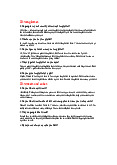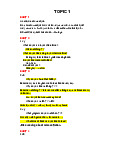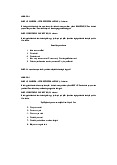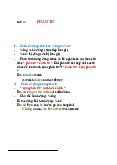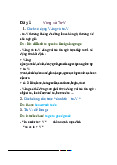



Preview text:
PASSAGE 27
Reading to oneself is a modern activity which was almost unknown to the scholars of the classic
medieval worlds, while during the fifteenth century the term "reading" undoubtedly meant reading aloud.
Only during the nineteenth century did silent reading become commonplace.
One should be wary, however, of assuming that silent reading came about simply because reading
aloud was a distraction to others. Examinations of factors related to the historical development of silent
reading have revealed that it became the usual mode of reading for most adults mainly because the tasks
themselves changed in character.
The last century saw a steady gradual increase in literacy and thus in the number of readers. As the
number of readers increased, the number of potential listeners declined and thus there was some reduction
in the need to read aloud. As reading for the benefit of listeners grew less common, so came the
flourishing of reading as a private activity in such public places as libraries, railway carriages and offices,
where reading aloud would cause distraction to other readers.
Towards the end of the century, there was still considerable argument over whether books should be
used for information or treated respectfully and over whether the reading of materials such as newspapers
was in some way mentally weakening. Indeed, this argument remains with us still in education. However,
whatever its virtues, the old shared literacy culture had gone and was replaced by the printed mass media
on the one hand and by books and periodicals for a specialized readership on the other.
By the end of the twentieth century, students were being recommended to adopt attitudes to books and to
use reading skills which were inappropriate, it not impossible, for the oral reader. The social, cultural
and technological changes in the century had greatly altered what the term "reading" implied.
Question 1. Reading aloud was more common in the medieval world because
A. people relied on reading for entertainment
B. there were few places available for private reading
C. few people could read to themselves
D. silent reading had not been discovered
Question 2. The word "commonplace" in the first paragraph mostly means " "
A. attracting attention B. most preferable C. widely used D. for everybody's use
Question 3. The development of silent reading during the last century indicated
A. a change in the nature of reading
B. an increase in the average age of readers
C. an increase in the number of books
D. a change in the status of literate people
Question 4. Silent reading, especially in public places, flourished mainly because of
A. the development of libraries
B. the increase in literacy
C. the decreasing need to read aloud
D. the decreasing number of listeners
Question 5. The phrase "a specialized readership” in paragraph 4 mostly means “ ".
A. a requirement for readers in a particular area of knowledge
B. a limited number of readers in a particular area of knowledge
C. a status for readers specialized in mass media
D. a reading volume for particular professionals
Question 6. The phrase "oral reader” in the last paragraph mostly means "a person who ” Page 1
A. is good at public speaking
B. takes part in an audition
C. practices reading to an audience
D. is interested in spoken language
Question 7. All of the following might be the factors that affected the continuation of the old shared literacy culture EXCEPT
A. the diversity of reading materials
B. the specialized readership
C. the inappropriate reading skills
D. the printed mass media
Question 8. The writer of this passage is attempting to
A. emphasize that reading aloud was more common in the past than it is today
B. encourage the growth of reading
C. show how reading method has been improved
D. change people's attitudes towards reading ĐÁP ÁN 1-D 2-D 3-C 4-C 5-B 6-C 7-C 8-D LỜI GIẢI CHI TIẾT Question 1: D
Đọc to là phổ biến hơn trong thế giới thời trung cổ bởi vì
A. mọi người dựa vào việc đọc để giải trí
B. có vài nơi để đọc riêng
C. ít người có thể tự đọc
D. đọc thầm không được phát hiện
DẪN CHỨNG: Reading to oneself is a modern activity which was almost unknown to the scholars of the
classic medieval worlds, while during the fifteenth century the term "reading" undoubtedly meant reading aloud.
DỊCH: Đọc cho chính mình là một hoạt động hiện đại mà hầu như các học giả của thế giới trung cổ cổ
điển gần như không biết, trong khi trong thế kỷ mười lăm, thuật ngữ "đọc" chắc chắn có nghĩa là đọc to. Question 2: D
Từ "commonplace" trong đoạn đầu tiên chủ yếu có nghĩa là "_" A. thu hút sự chú ý B. thích hợp nhất
C. được sử dụng rộng rãi D. Việc sử dụng của mọi người
DẪN CHỨNG: Reading to oneself is a modern activity which was almost unknown to the scholars of the
classic medieval worlds, while during the fifteenth century the term "reading" undoubtedly meant reading
aloud. Only during the nineteenth century did silent reading become . commonplace
DỊCH: Đọc cho chính mình là một hoạt động hiện đại mà hầu như các học giả của thế giới trung cổ cổ
điển gần như không biết, trong khi trong thế kỷ mười năm, thuật ngữ "đọc" chắc chắn có nghĩa là đọc to.
Chỉ trong thế kỷ XIX, việc đọc thầm đã trở nên phổ biến. Question 3: C
Sự phát triển của việc đọc thầm trong thế kỷ trước chỉ ra Page 2
A. một sự thay đổi trong bản chất của việc đọc
B. sự gia tăng tuổi trung bình của độc giả C. tăng số lượng sách
D. một sự thay đổi trong tình trạng của những người biết chữ
DẪN CHỨNG: As the number of readers increased, the number of potential listeners declined and thus
there was some reduction in the need to read aloud. As reading for the benefit of listeners grew less
common, so came the flourishing of reading as a private activity in such public places as libraries, railway
carriages and offices, where reading aloud would cause distraction to other readers.
DỊCH: Khi số lượng độc giả tăng lên, số lượng người nghe tiềm năng giảm xuống và do đó có một số
giảm nhu cầu đọc to. Khi việc đọc vì lợi ích của người nghe ngày càng ít phổ biến, do đó, việc đọc thành
một hoạt động riêng tư ở những nơi công cộng như thư viện, toa xe lửa và văn phòng, việc đọc to sẽ gây
mất tập trung cho những người đọc khác. Question 4: C
Đọc thầm, đặc biệt là ở những nơi công cộng, phát triển chủ yếu vì
A. sự phát triển của các thư viện
B. sự gia tăng tỷ lệ biết chữ
C. nhu cầu đọc to giảm đi
D. số lượng người nghe giảm dần
DẪN CHỨNG: One should be wary, however, of assuming that silent reading came about simply
because reading aloud was a distraction to others.
DỊCH: Tuy nhiên, người ta nên cảnh giác khi cho rằng việc đọc thầm lặng xuất hiện đơn giản vì đọc to là
một sự phân tâm đối với người khác. Question 5: B
Cụm từ "a specialized readership ’’, trong đoạn 4, chủ yếu có nghĩa là ".
A. một yêu cầu cho độc giả trong một lĩnh vực kiến thức cụ thể
B. một số lượng độc giả hạn chế trong một lĩnh vực kiến thức cụ thể
C. một trạng thái cho độc giả chuyên ngành truyền thông đại chúng
D. một khối lượng đọc cho các chuyên gia cụ thể
DẪN CHỨNG: However, whatever its virtues, the old shared literacy culture had gone and was replaced
by the printed mass media on the one hand and by books and periodicals for a specialized readership on the other.
DỊCH: Tuy nhiên, bất kể ưu điểm của nó là gì, văn hóa chia sẻ cũ đã biến mất và được thay thế bằng các
phương tiện thông tin đại chúng được in một mặt và các cuốn sách và tạp chí định kỳ cho một độc giả chuyên ngành. Question 6: C
Cụm từ "oral reader 'trong đoạn cuối hầu hết có nghĩa là" một người
A. giỏi nói trước công chúng
B. tham gia một buổi thử giọng
C. thực hành đọc cho khán giả D. thích ngôn ngữ nói Page 3
DẪN CHỨNG: By the end of the twentieth century, students were being recommended to adopt attitudes
to books and to use reading skills which were inappropriate, it not impossible, for the oral reader.
DỊCH: Vào cuối thế kỷ XX, sinh viên được khuyến nghị áp dụng thái độ đối với sách và sử dụng các kỹ
năng đọc không phù hợp, điều đó không phải là không thể đối với người đọc bằng miệng. Question 7: C
Tất cả những điều sau đây có thể là các yếu tố ảnh hưởng đến sự tiếp nối của văn hóa xóa mù chữ chia sẻ cũ NGOẠI TRỪ
A. sự đa dạng của tài liệu đọc B. độc giả chuyên ngành
C. kỹ năng đọc không phù hợp
D. các phương tiện truyền thông đại chúng được in
DẪN CHỨNG: Câu A, B, B: . However, whatever its virtues, the old shared literacy culture had gone
and was replaced by the printed mass media on the one hand and by books and periodicals for a
specialized readership on the other.
DỊCH: Tuy nhiên, bất kể ưu điểm của nó là gì, văn hóa chia sẻ cũ đã biến mất và được thay thế bằng các
phương tiện thông tin đại chúng được in một mặt và các cuốn sách và tạp chí định kỳ cho một độc giả chuyên ngành. Question 8: D
Nhà văn của đoạn văn này đang cố gắng để
A. nhấn mạnh rằng đọc to là phổ biến trong quá khứ hơn ngày nay.
B. khuyến khích sự tăng trưởng của việc đọc
C. cho thấy phương pháp đọc đã được cải thiện như thế nào
D. thay đổi thái độ của mọi người đối với việc đọc.
DẪN CHỨNG: By the end of the twentieth century, students were being recommended to adopt attitudes
to books and to use reading skills which were inappropriate, it not impossible, for the oral reader. The
social, cultural and technological changes in the century had greatly altered what the term "reading" implied.
DỊCH: Vào cuối thế kỷ XX, sinh viên được khuyến nghị áp dụng thái độ đối với sách và sử dụng các kỹ
năng đọc không phù hợp, điều đó không phải là không thể đối với người đọc bằng miệng. Những thay đổi
xã hội, văn hóa và công nghệ trong thế kỷ đã làm thay đổi đáng kể thuật ngữ "đọc" ngụ ý. Page 4
